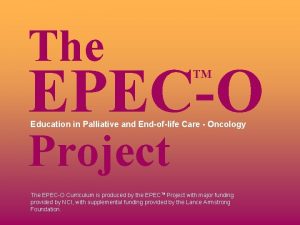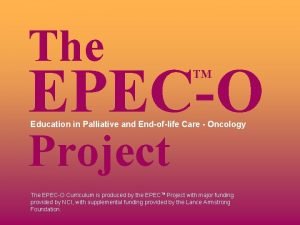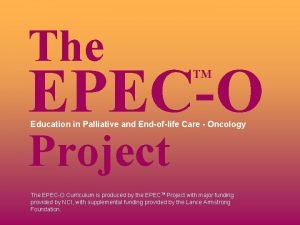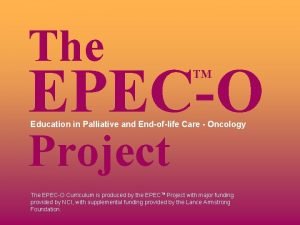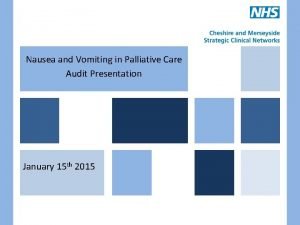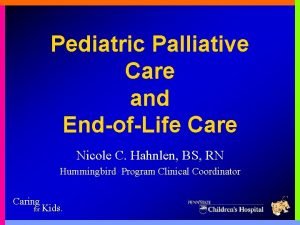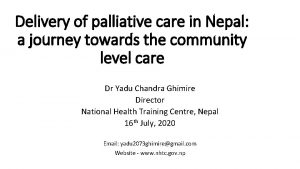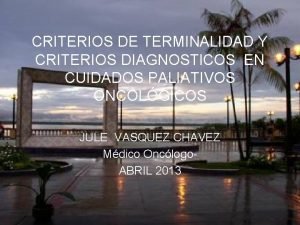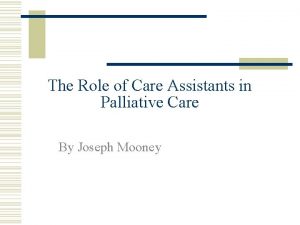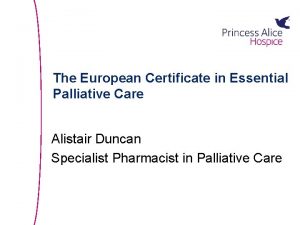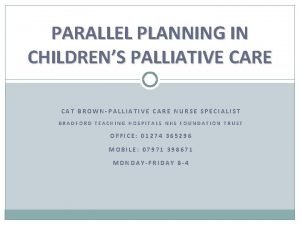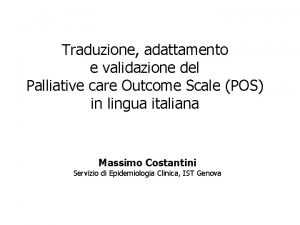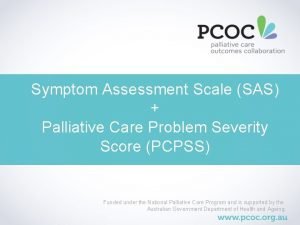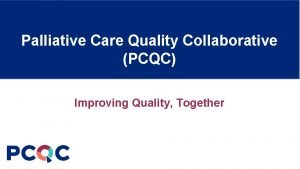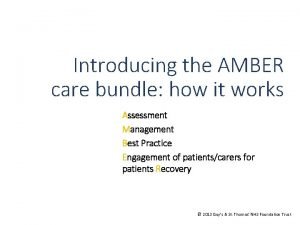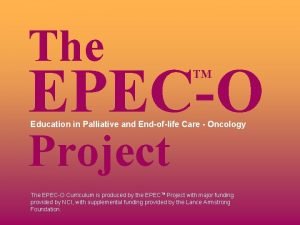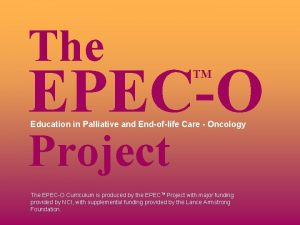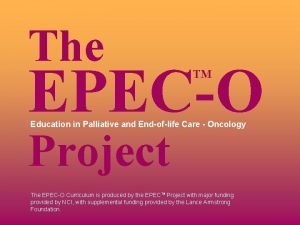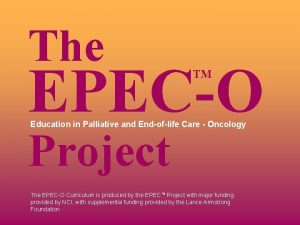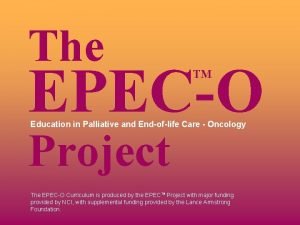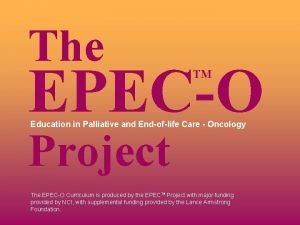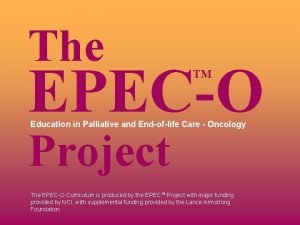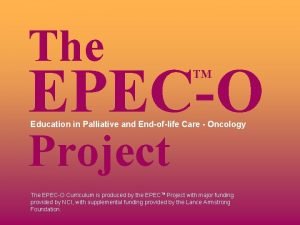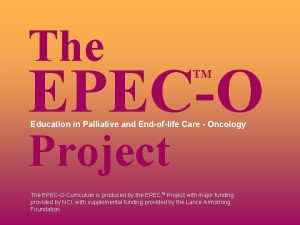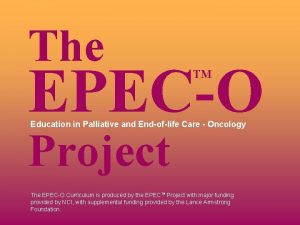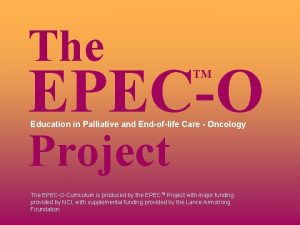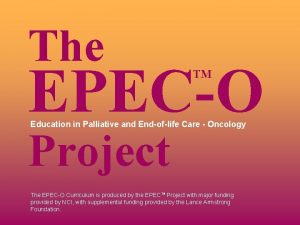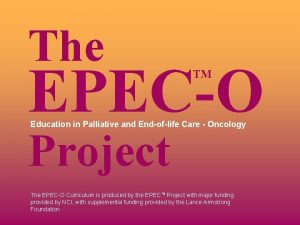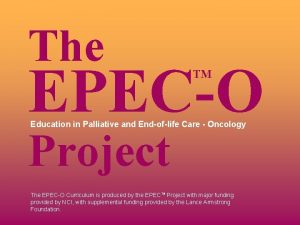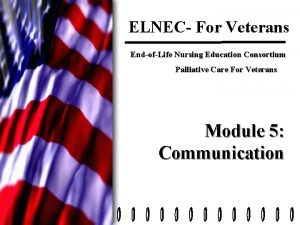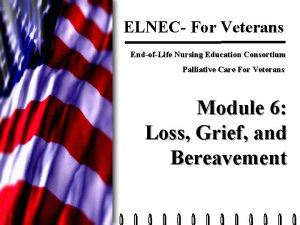The EPECO TM Education in Palliative and Endoflife


























- Slides: 26

The EPEC-O TM Education in Palliative and End-of-life Care - Oncology Project The EPEC-O Curriculum is produced by the EPECTM Project with major funding provided by NCI, with supplemental funding provided by the Lance Armstrong Foundation.

E P E C O EPEC - Oncology Education in Palliative and End-of-life Care - Oncology Module 7 Communicating Effectively

Overall message A structured approach to communicating helps the oncologist perform this important role

Objectives l Demonstrate ability to apply a 6 -step protocol for delivering information Know what to do at each step

Video

Importance l l Most people want to know Strengthens physician-patient relationship Fosters collaboration Permits patients, families to plan, cope

6 -step protocol. . . 1. Getting started 2. Find out what the patient knows 3. Find out how much the patient wants to know Adapted from Robert Buckman

. . 6 -step protocol 4. Share the information 5. Respond to patient, family feelings 6. Plan, follow-up Adapted from Robert Buckman

Step 1: Getting started. . . l Plan what you will say Confirm medical facts Don’t delegate l Create a conducive environment

. . . Getting started l Allot adequate time Prevent interruptions l Determine who else the patient would like present If child, patient’s parents

Step 2: What does the patient know? l Establish what the patient knows Child’s parents l l Assess ability to comprehend new bad news Reschedule if unprepared

Step 3: How much does the patient want to know. . . l Recognize, support various patient preferences Decline voluntarily to receive information Designate someone to communicate on his or her behalf

. . . Step 3: How much does the patient want to know l People handle information differently Race, ethnicity, culture, religion, socioeconomic status Age and developmental level

Advance preparation l Initial assessment l Preparation for critical tests What does the patient know? (step 2) How does the patient handle information? (step 3)

When family says ‘don’t tell’. . . l Legal obligation to obtain informed consent from the patient l Promote congenial family alliance l Honesty with a child promotes trust

. . . When family says ‘don’t tell’ l Ask the family: Why not tell? What are you afraid I will say? What are your previous experiences? Is there a personal, cultural, or religious context? l Talk to the patient together

Step 4: Share the information. . . l Say it, then stop Avoid monologue, promote dialogue Avoid jargon, euphemisms Pause frequently Check for understanding Use silence, body language

. . . Step 4: Share the information l Don’t minimize severity Avoid vagueness, confusion l Implications of “I’m sorry”

Step 5: Respond to feelings. . . Normal reactions l Affective response Tears, anger, sadness, love, anxiety, relief, other l Cognitive response Denial, blame, guilt, disbelief, fear, loss, shame, intellectualization l Basic psychophysiologic response Fight-flight

. . . Step 5: Respond to feelings. . . l Be prepared for Outburst of strong emotion Broad range of reactions l Give time to react

. . . Step 5: Respond to feelings l Listen quietly, attentively l Encourage descriptions of feelings l Use non-verbal communication

Step 6: Planning, follow-up. . . l Plan for the next steps Additional information, tests Treat symptoms, referrals as needed l Discuss potential sources of support

. . . Step 6: Planning, follow-up l l Give contact information, set next appointment Before leaving, assess: Safety of the patient Supports at home l Repeat news at future visits

When language is a barrier. . . l Use a skilled translator Familiar with medical terminology Comfortable translating bad news l consider telephone translation services

. . . When language is a barrier l Avoid family as primary translators Confuses family members How to translate medical concepts Modify news to protect patient Supplement the translation l Speak directly to the patient

E P E C O Summary A structured approach to communicating helps the oncologist perform this important role
 Epeco
Epeco Epeco
Epeco Epeco
Epeco Epeco
Epeco Epeco
Epeco Epeco
Epeco Epeco
Epeco Franciscan hospice and palliative care
Franciscan hospice and palliative care Antiemetic ladder
Antiemetic ladder Edmonton symptom assessment system
Edmonton symptom assessment system Rug adl score
Rug adl score Hospice satisfaction survey
Hospice satisfaction survey Principles of palliative care
Principles of palliative care Palliative care versus hospice care
Palliative care versus hospice care Palliative care in nepal
Palliative care in nepal Pps scale hospice
Pps scale hospice Criterio de terminalidad
Criterio de terminalidad Palliative care assistant
Palliative care assistant European certificate in palliative care
European certificate in palliative care Parallel planning palliative care
Parallel planning palliative care Adjuvant neoadjuvant palliative
Adjuvant neoadjuvant palliative Hospice traduzione
Hospice traduzione Sas scale
Sas scale Log80 ausl romagna
Log80 ausl romagna Pcqc registry
Pcqc registry Just in case bag palliative care
Just in case bag palliative care Amber care bundle nice
Amber care bundle nice
